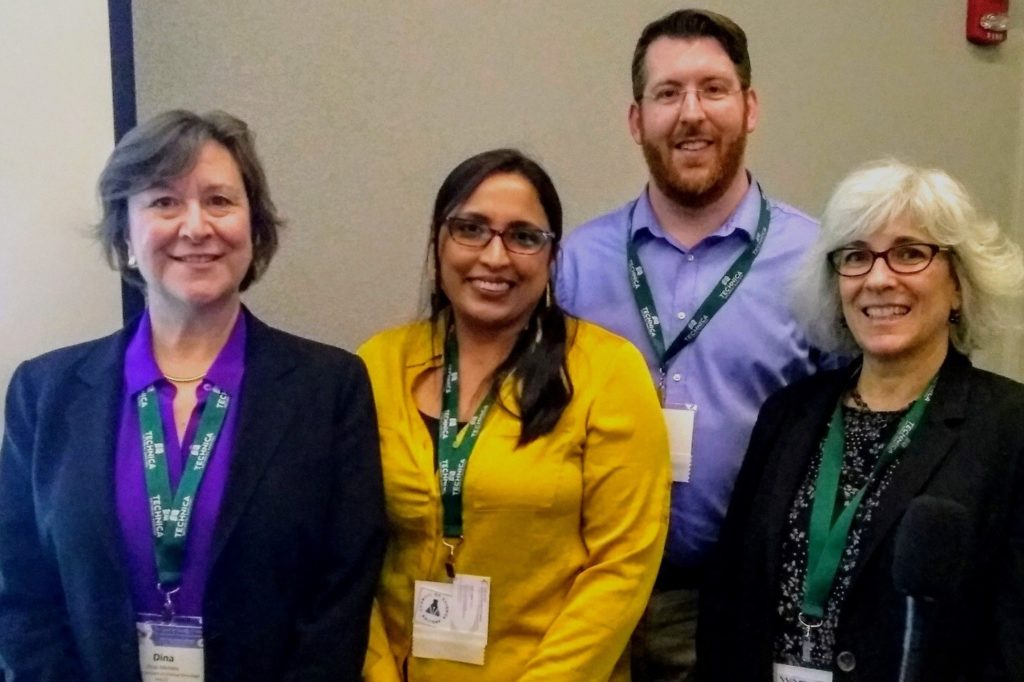MODERATOR:
Sofia Dorsano
World Allergy Organization
Milwaukee, Wisconsin
SPEAKERS:
Sabina Alam
Taylor and Francis Group
Abingdon, United Kingdom
Patrick Hannon
New England Journal of Medicine
Boston, Massachusetts
Dina Michels
American Society of Clinical Oncology
Alexandria, Virginia
REPORTER:
Andrea Kunz
Society for Immunotherapy of Cancer
Milwaukee, Wisconsin

Addressing the growing concern about competing interest transparency among authors, reviewers, and editors is a resource challenge for journals. The CSE 2019 Annual Meeting session “Managing Conflict of Interest Disclosure—Where Are We Going?” identified common challenges in conflict disclosures and provided a platform for attendees to consider opportunities for harmonizing the process.
The session began with Dina Michels identifying how challenging it can be for authors to disclose all applicable financial relationships. Noting that a lack of disclosure standards can make an author’s or editor’s task more difficult, time-consuming, and open to errors, she emphasized the importance of developing a common disclosure framework that standardizes categories, definitions, questions, and timeframes. It was also stressed that, as an issue that extends beyond journal-related activity, development of best disclosure practices is a shared responsibility. She stated that having a clear, transferable framework across platforms can make the process easier for all involved.
It was noted that the Centers for Medicare and Medicaid Services (CMS) Open Payments program,1 which was developed in order to promote greater transparency of financial relationships between health care providers and applicable conflicting companies, has become a common source for finding information about payments to US physicians. When comparing information self-disclosed by an author to a journal to information reported by companies in Open Payments, Michels pointed out that there are often discrepancies that may be explained in part because some journals specify author disclosure of relationships that are “relevant” to the manuscript rather than general disclosure of the author’s relationships.
Sabina Alam echoed and expanded upon the challenges of conflict of interest declarations. Challenges addressed included confusion caused by terminology (i.e., conflict of interest versus competing interest), overlooking nonfinancial/personal conflicts, differing stated policies from one journal to another, determining what data is stored and for how long, and identifying how editors and reviewers view author declarations. Alam noted that staff, the editor-in-chief, and other editors should be engaged in the process of understanding and upholding conflict of interest declarations and resolution practices in order to ensure they are clearly followed.
Alam noted that an available resource to help ensure the greatest continuity across journals can be found through the conflict of interest guidance of the International Committee of Medical Journal Editors (ICMJE).2 ICMJE offers a six-part disclosure form with instructions for electronic completion and storage that supplies reviewers with information about any interests of an author that could potentially influence how the work is received by the reviewer and public. She shared that providing ICMJE definitions within the system rather than referring authors to a separate site increases the likelihood that authors will read and understand what they are declaring. Given that personal and career changes can occur for authors during the time that a manuscript is going through the peer review process, she also indicated that conflicts of interest provided at submission should be confirmed at the revision or acceptance stage to ensure they are still accurate and complete before publishing.
To close the session, Patrick Hannon provided an overview and demo of the Association of American Medical Colleges (AAMC) disclosure platform, Convey Global Disclosure System (Convey).3 Convey was developed to act as a central repository for individuals to enter and maintain their financial interest records.4 It is free for individual researchers and carries an annual fee for participating organizations.
AAMC and ICMJE are closely following the pilots of Convey that are currently underway with Annals of Internal Medicine (AIM) and New England Journal of Medicine (NEJM). Hannon demonstrated the four stages for submitting a disclosure to NEJM through Convey:
- Reviewing journal policies and instructions,
- Entering interests,
- Responding to additional questions (often customized by journals), and
- Reviewing and submitting the disclosure information.
Participating organizations can tailor conflict requests depending on their specific needs. Convey then recognizes which types of conflicts are required for each participating organization and saves authors the step of having to do so themselves. This allows authors to submit to multiple sources with differing disclosure criteria much faster and using consistent terminology and declaration formats. Journals also have the ability to pull the disclosure information they receive as PDF or XML files, providing journals with options on how they display and report financial conflicts. On the horizon, Hannon noted that Convey is looking into the development of a form that could be free for authors to use and submit to nonparticipating organizations, as well. Additionally, there are some early discussions underway on integration possibilities with existing review platforms.
After some audience discussion after speaker presentations, a primary takeaway shared by speakers and attendees alike was that journals should work together to create a strong combined voice that advocates for the implementation of a standardized, integrated disclosure collection system that will aide in moving science forward more effectively and efficiently.
References and Links
- https://www.cms.gov/openpayments/
- http://www.icmje.org/conflicts-of-interest/
- https://www.aamc.org/services/498864/convey.html
- Mann S. Convey: a new system to simplify the process for disclosing financial interests. AAMC Rep 2016;25(3). https://news.aamc.org/research/article/convey-new-system-simplify-process-disclosing-fina/
